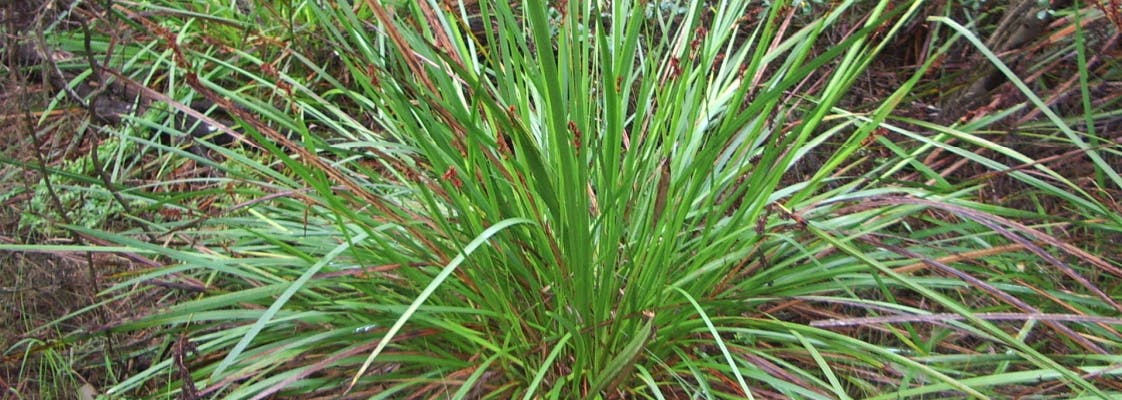
&w=3840&q=75)
Green Kangaroo Paw
Botanical name: Anigozanthos viridis
Common name: Green Kangaroo Paw, Swamp Kangaroo Paw
Noongar name: Koroylbardany, Koroylbardang
Description: Rhizomatous, perennial, herb, 0.05-0.85m high. Flowers are green/yellow-green from Aug to Oct.
Soil/habitat: Sand, loam, clay. Winter-wet areas.
Cultural use: The roots were eaten either raw or roasted in hot ashes. Sometimes roots were ground into a paste which was then formed into cakes and baked in hot ashes.
&w=3840&q=75)
Purngep, Pining or Binga
Botanical name: Atriplex nummularia
Common name: Old Man Saltbush
Noongar name: Purngep, Pining or Binga
Description: A woody shrub up to 3m high, grown in the ground or pots.
Soil/habitat: Tolerates drought, salinity and sandy soil in the wild, a rich and loamy, but free-draining soil.
Cultural use: Commonly used today as a livestock grazing plant. The seeds and leaves are viable bush tucker, with the leaves salty in flavour and rich in protein, antioxidants and minerals. Enjoy leaves blanched, sautéed, wrapped around meat or fish, used in salads, or for stuffing poultry or dried as a herb or sprinkle.
&w=3840&q=75)
Bulbine bulbosa
Botanical name: Bulbine bulbosa
Common name: Native Leek, Bulbine Lily or Wild Onion
Noongar name: Pike (Woiwurrung), Parm, Puewan
Description: A small plant, reaching a 40cm height and 30cm width, grass-like appearance and bright yellow star-shaped flowers from September to March.
Soil/habitat: A loamy soil that holds plenty of water, in full sun or dappled shade.
Cultural use: Has edible seeds used similar to fennel seeds, roots and below-ground corms that are a tasty bushfood and contains calcium and iron and was likely roasted before eating. The corm’s protruding roots are also edible, with a mild oniony flavour.
&w=3840&q=75)
Common Net Bush
Botanical name: Calothamnus lateralis
Common name: Common Net Bush or One-sided Bottlebrush
Description: Erect shrub 0.4 to 1.5m high. Flowers are red from August to December.
Soil/habitat: Swamps and winter wet depressions.
&w=3840&q=75)
One-sided Bottlebrush
Botanical name: Calothamnus quadrifidus
Common name: One-sided Bottlebrush
Noongar name: Kwowdjard, Quietjat
Description: Erect, compact or spreading shrub, 0.9-2m high. Flowers are red/white-yellow from Jun to Dec.
Soil/habitat: Wide variety of soils & habitats.
Cultural use: Flowers were a good source of nectar and were either sucked directly or soaked in water to make a sweet drink, often left to ferment to become an alcoholic drink.
&w=3840&q=75)
Darwinia
Botanical name: Darwinia citriodora prostrate seaspray
Common name: Darwinia
Description: Low mounding groundcover, 0.5-1m high, spreads up to 1m. Flowers are vivid orange-red, attracts honeyeaters, butterflies and bees.
Soil/habitat: Sandy, loamy well-drained soils.
&w=3840&q=75)
Karkalla
Botanical name: Disphyma crassifolium (subspecies Clavellatum)
Common name: Round Baby Pigface, Noonflower, Iceplant or Purple Dewplant
Noongar name: Karkalla
Description: A low growing perennial ground shrub, 2–30cm high, 1–2m spread.
Soil/habitat: Well-adapted to a range of soil types including sand, loam and clay. A freely draining soil in a full-sun or partly shaded position.
Cultural use:Its rich, sweet fruits were a seasonal favourite among Aboriginal families, to complement summertime seafood. Edible leaves, traditionally served cooked as an accompaniment to game meat. A juicy, refreshing burst of flavour in salads, stir-fries, pickles and as a flavoursome ingredient in seafood dishes.
&w=3840&q=75)
Emu Bush
Botanical name: Eremophila nivea
Common name: Emu Bush
Description: Silvery foliaged shrub, 0.8-2m, spreads up to 2m. Flowers are purple tubular from Aug to Jan and May to Jul. Attracts bees, nectar eating birds, butterflies.
Soil/habitat: Dry, well drained, loamy, sandy load, clay loam, potting mix.
&w=3840&q=75)
Yangjet
Botanical name: Ficinia nodosa
Common name: Knobby Club-rush
Noongar name: Yangjet
Description: Erect, perennial herb (sedge), to 1m high. Flowers are brown/cream from Oct to Dec or Jan.
Soil/habitat: White sand, dark sandy clay, granite, limestone. Coastal dunes, flats, seasonally-wet swamplands, shores of salt lakes.
Cultural use: Roots are edible and were probably roasted in hot ashes before being eaten. Stalks were sometimes used to weave nets for catching fish and turtles.
&w=3840&q=75)
Running Postman
Botanical name: Kennedia prostrata
Common name: Running Postman
Noongar name: Wollung, Pulbarn, Kuralo, Wollong
Description: Prostrate or twining shrub.
Soil/habitat: Usually sandy gravelly soils.
Cultural use: The flowers provide a source of sweet nectar that can be sucked straight from the flower. Leaves are used to make a tea-like drink, which has a pleasant liquorice flavour. Nectar was used to soothe sore throats.
&w=3840&q=75)
Sword sedge
Botanical name: Lepidosperma gladiatum
Common name: Sword sedge
Description: Rhizomatous, tufted robust perennial, grass-like or herb (sedge), 0.5-3m high, clumps to 1.5m wide. Flowers are brown from Nov to Dec or Jan to May.
Soil/habitat: White, grey or calcareous sand, limestone, loam. Dunes, creeklines.
&w=3840&q=75)
Slender Mint
Botanical name: Mentha diemenica
Common name: Slender Mint, Wild Mint
Description: A suckering plant that grows about 10cm high and with a seemingly endless spread if permitted to run wild.
Soil/habitat: Loves damp conditions and part-shade.
Cultural use:Use in salads, sandwiches, deserts, cocktails, water infusions and salt infusions. Leaves may be used fresh, or chopped and dried for later use.
&w=3840&q=75)
Boobiala
Botanical name: Myoporum insulare
Common name: Coastal Boobialla, Native Juniper
Noongar name: Boobiala
Description: Dense, low spreading or erect shrub or tree (occasionally), 0.25m-5m high. Flowers are white from Jul to Dec or Jan to Feb.
Soil/habitat: White/grey sand. Coastal dunes and limestone.
Cultural use: Fruits are edible when ripe (bitter and salty).
&w=3840&q=75)
Twin-leaf Myoporum
Botanical name: Myoporum oppositifolium
Common name: Twin-leaf Myoporum
Description: Erect slender or sprawling shrub, 0.4-1.5m high. Flowers are white/white-purple from Aug to Dec or Jan or Mar to Apr.
Soil/habitat: Sandy soils, loam. Coastal areas, along creeks and rivers.
&w=3840&q=75)
Pimelea ferruginea 'magenta'
Botanical name: Pimelea ferruginea 'magenta'
Common name: Rice Flower
Description: Small shrub with small dark green glossy leaves, 1-1.2m, spreads up to 1m. Flowers are magenta pink tubular from Aug to Oct. Attracts bees, butterflies, insects.
Soil/habitat: Well drained, loamy, sandy loam, potting mix. Drought resistant.

